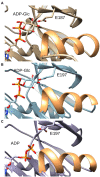Carbohydrate Metabolism in Bacteria: Alternative Specificities in ADP-Glucose Pyrophosphorylases Open Novel Metabolic Scenarios and Biotechnological Tools
- PMID: 35572620
- PMCID: PMC9093745
- DOI: 10.3389/fmicb.2022.867384
Carbohydrate Metabolism in Bacteria: Alternative Specificities in ADP-Glucose Pyrophosphorylases Open Novel Metabolic Scenarios and Biotechnological Tools
Abstract
We explored the ability of ADP-glucose pyrophosphorylase (ADP-Glc PPase) from different bacteria to use glucosamine (GlcN) metabolites as a substrate or allosteric effectors. The enzyme from the actinobacteria Kocuria rhizophila exhibited marked and distinctive sensitivity to allosteric activation by GlcN-6P when producing ADP-Glc from glucose-1-phosphate (Glc-1P) and ATP. This behavior is also seen in the enzyme from Rhodococcus spp., the only one known so far to portray this activation. GlcN-6P had a more modest effect on the enzyme from other Actinobacteria (Streptomyces coelicolor), Firmicutes (Ruminococcus albus), and Proteobacteria (Agrobacterium tumefaciens) groups. In addition, we studied the catalytic capacity of ADP-Glc PPases from the different sources using GlcN-1P as a substrate when assayed in the presence of their respective allosteric activators. In all cases, the catalytic efficiency of Glc-1P was 1-2 orders of magnitude higher than GlcN-1P, except for the unregulated heterotetrameric protein (GlgC/GgD) from Geobacillus stearothermophilus. The Glc-1P substrate preference is explained using a model of ADP-Glc PPase from A. tumefaciens based on the crystallographic structure of the enzyme from potato tuber. The substrate-binding domain localizes near the N-terminal of an α-helix, which has a partial positive charge, thus favoring the interaction with a hydroxyl rather than a charged primary amine group. Results support the scenario where the ability of ADP-Glc PPases to use GlcN-1P as an alternative occurred during evolution despite the enzyme being selected to use Glc-1P and ATP for α-glucans synthesis. As an associated consequence in such a process, certain bacteria could have improved their ability to metabolize GlcN. The work also provides insights in designing molecular tools for producing oligo and polysaccharides with amino moieties.
Keywords: allosterism; glucosamine-1-phosphate; glucosamine-6-phosphate; glucose-1-phosphate; promiscuity.
Copyright © 2022 Bhayani, Iglesias, Minen, Cereijo, Ballicora, Iglesias and Asencion Diez.
Conflict of interest statement
The authors declare that the research was conducted in the absence of any commercial or financial relationships that could be construed as a potential conflict of interest.
Figures



References
-
- Álvarez-Añorve L. I., Gaugué I., Link H., Marcos-Viquez J., Díaz-Jiménez D. M., Zonszein S., et al. (2016). Allosteric activation of Escherichia coli glucosamine-6-phosphate deaminase (NagB) in vivo justified by intracellular amino sugar metabolite concentrations. J. Bacteriol. 198, 1610–1620. doi: 10.1128/JB.00870-15, PMID: - DOI - PMC - PubMed
LinkOut - more resources
Full Text Sources
Research Materials
Miscellaneous

